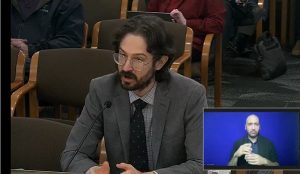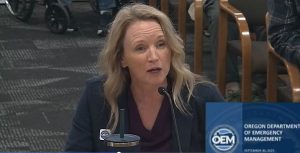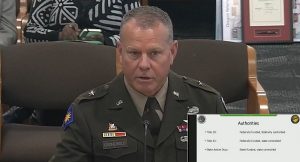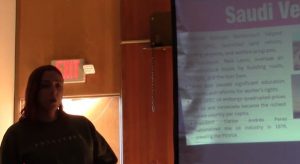Klamath teams monitor salmon above former dam site
16 min read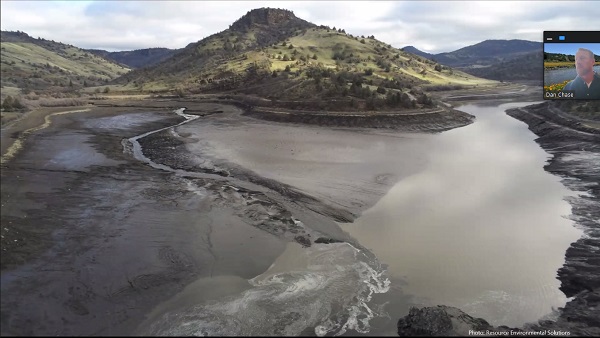
Salmon return to the Upper Klamath for the first time in over a century. Four dams were removed in time for the fall run. Now the project focus turns to monitoring. During an hourlong Zoom session Oct. 31:
Amy Bowers Cordalis (Ridges to Riffles): My name is Amy Bowers Cordalis. I am a member of the Yurok Tribe, I’m the founder and executive director of the Ridges to Riffles Indigenous Conservation Group, a fisherwoman and also an attorney for the Yurok Tribe.
[00:00:29] The Klamath used to be the third-largest salmon-producing river in the lower continental, and it supported a wide range of ecosystem needs and also Indigenous people throughout the entire basin.
[00:00:42] And so our goal is to restore those wild salmon runs to be able to support the ecosystem and the people who have been dependent upon it for generations, but also the new people that are here now too. So recreational fisheries, offshore fisheries as well.
[00:00:59] I also wanted to comment that even the whales need the Klamath River salmon, right? The Southern Oregon Orca population is on the endangered species list because there aren’t enough Klamath salmon to support their needs.
[00:01:14] And so our goal is to restore the balance between humans and nature, not just within the Klamath basin, but also within the ocean environment that are dependent on Klamath salmon. And we do that through these nature-based solutions, right? Klamath dam removal is all about nature-based solutions.
[00:01:38] And we’re seeing that our salmon and the river is already exceeding our expectations. And so our goal is to really restore that balance. And what’s so important is that the river is showing us how it will heal.
[00:01:54] And all these people are using both traditional knowledge, Indigenous knowledge, and marrying it with Western modern science to observe and to show and to tell us how the river is healing and it’s really a remarkable opportunity. It’s a remarkable time.
[00:02:13] We all get to be the generation that sees the rivers restoration, the salmon’s restoration, and then the river’s ability to then support the humans. So thank you all for participating. Thank you to all of our partners in this historical moment. And it’s just really an inspiration. And I’m just honored to be here and to work with all of these folks.
[00:02:39] Dan Chase (Resource Environmental Solutions): This project was over two decades in development, and this period included extensive studies and evaluations on how best to remove four dams that have been impounding water and sediment for over a century.
[00:02:50] The guidance and direction from biologists, natural resource managers, and the Tribal community was to start the drawdown of the large reservoirs and to release that trapped sediment in the winter. And this was a time the river usually carries the most sediment that would be less impactful to fish and aquatic organisms like salmon and steelhead because the main stem river occupancy was lowered.
[00:03:12] So that, coupled with the rapid schedule of removing all four dams in about a 16-month period, was done to minimize the duration of the impact on the river and accelerate the recovery of the system.
[00:03:23] While dam removal is complete, the project is not, and now moves fully into the restoration phase. As the fish return, they find a new landscape, one that has changed quite a bit and does not really resemble the streams that they were in before the dams were in place. And it’s still raw and changing from removal of reservoirs only months prior.
[00:03:46] Our responsibility is to accelerate the recovery of these formerly drowned lands, connecting floodplains, shaping channels, adding habitat, and reestablishing native plant communities.
[00:04:00] Barry McCovey (Yurok Tribe): I want to talk a little bit about monitoring. Why we’re doing this monitoring, why all this monitoring that we’re doing is so important, and why we’re doing so much of it. This is going to be focused on adult monitoring and some water quality stuff, but just know that there’s a lot of other monitoring that’s going on. There’s monitoring that’s looking at ecosystem function, whether it’s aquatic invertebrates or algae, folks out there who are looking at how the ecosystem is recovering after a dam removal and how things are recolonizing, not just fish, but other animals are recolonizing these areas.
[00:04:36] Monitoring is very broad. We’re a little bit focused today on the fish and a little bit of water quality, but why is this so important? Why is monitoring these adult fish so important?
[00:04:49] For one thing, all the data that we’re collecting now will go into a process where we can predict or we can estimate how big the run was in the Klamath this year. That helps with management with the Pacific Fisheries Management Council and others, kind of predict what runs are going to be in the future. That has ramifications to Tribal fisheries, to state fisheries, to in-river fisheries, to ocean fisheries, so all this data is extremely important in those processes.
[00:05:21] Another reason why the adult data is very important to collect, especially in the newly formed river channel and the newly accessible tributaries above Iron Gate is we’re learning a lot about recolonization. We’re learning how these fish are recolonizing new areas. This type of thing doesn’t happen very often. And so the more information we can gather on how fish are using these new areas, the better. This can help inform future dam removals. This can help inform future colonization or supplementation efforts. So it’s really important in that respect.
[00:05:57] And then another really important aspect of monitoring these adult fish, which a lot of people are going to talk about today is they help to inform us of what they like, what’s working, what’s not working. They’re telling us what type of habitat they’re using. They’re telling us what type of habitat they’re lacking.
[00:06:16] So when we move forward into the future, and we start thinking about restoration and prioritizing restoration actions, these fish are helping inform managers on what restoration actions can be taken to help them. Because nothing’s been done yet, this is a blank slate and the fish are already using this blank slate and it can only get better. We can do a lot of restoration work and we can make these areas better.
[00:06:40] So that’s kind of what we’re thinking about here when we’re talking about why we’re monitoring the adult salmon. Of course, there’s more monitoring to come. We need to monitor the juveniles as they’re out migrating. So the progeny or offspring of these fish that are spawning in these tributaries and manes them right now, we need to get a good handle on those fish and how they’re making their way out of these tributaries and out of the newly formed river channel, for many of the same reasons why we want to monitor the adults.
[00:07:10] It helps us with management actions, but it also helps inform restoration. So the juvenile fish are, and their survival as they’re leaving the system, is just important as the spawning fish. We need spawning habitat and we need juvenile rearing habitat.
[00:07:22] So later on, when all of us get together and we’re all monitoring the juveniles as they’re outmigrating, that’s really going to help inform managers and restorationists and help us prioritize what type of restoration actions need to be taken in this part of the river.
[00:07:42] Dr. Stephanie Quinn-Davidson (Ridges to Riffles): I’m Dr. Stephanie Quinn-Davidson with Ridges to Riffles Indigenous Conservation Group. We’re part of this large monitoring collaborative project and I’m excited to be a part of it and bring to the monitoring effort my decade plus of experience of working in Alaska on salmon fisheries, primarily on the Yukon River, where we use both sonar technology successfully to enumerate fish and radio telemetry to track fish along their 2,000-mile migration upriver.
[00:08:12] And so when people ask me if this is possible on the Klamath, the Klamath is obviously a very large river, these fish are migrating hundreds of miles upstream from the ocean, I can say, definitively, yes, we’re going to be able to track these fish, we’re going to be able to enumerate these fish and we are building on past success stories, again, that we are very confident that we’re going to be able to be successful with this.
[00:08:42] Toz Soto (Karuk Tribe): Yeah, I’m the fisheries program manager with the Karuk Tribe. And yeah, I think that while we’re still in the early stages of a reconnected river system, I can say, like Barry (McCovey) said, the fish have exceeded all our expectations, both in terms of their distribution upstream above the former dam sites and their health. It’s something that is pretty amazing.
[00:09:09] The Karuk Tribe played a huge role in all of this as everyone else did. The Karuk Tribe manages the network of publicly available real-time water quality gauges that monitor parameters such as water temperature, dissolved oxygen, the turbidity in the river, things like that.
[00:09:31] This network that the Tribe manages allowed and is still really important for adaptive management during the dam removal. And it played a huge part in the decision-making process to protect fish. So this monitoring is publicly available, like I said, on the Karuk Tribe’s water quality website.
00:09:54] So, you know, those kind of things made this whole process, you know, go smoother. And now we’re moving into this next phase of the dam removal. But I can say that, you know, we saw some immediate impacts. One of them was, we saw lower concentrations of harmful algae blooms. The microcystins concentrations were much lower. Water temperatures were quite a bit cooler, on the average of five degrees cooler. The reservoirs really were heat sinks.
[00:10:31] We’re in a period right now where days are much shorter, nights are longer, it’s cooling off, the river is a lot cooler and that’s really good for fish. Salmon are really influenced by water temperature. So all in all, the fish that came up this year were really healthy. So water temperature is already having an impact on the fish’s health.
[00:10:54] As far as the juveniles, it’s too early to tell, but our expectation is that next spring when the juveniles are outmigrating, we’re going to see a change in their health as well.
[00:11:08] Damon Goodman (California Trout): So, this sonar unit that we put in the river, what is a sonar and why are we using it? I mean, these things are basically like, think of a fancy fish finder, right? It’s got a transducer that goes in the water that generates radio waves that aren’t stopped by turbid water. So like during drawdown, for example, we had some pretty high turbidity times as sediment was working its way downriver and that also occurs during high streamflow events naturally in rivers.
[00:11:38] And so this is not something that is uncommon in our rivers, but these radio waves can go right through that sediment. And so basically those radio waves are set across the river in a certain spot. And it just at that thick spot, it’s waiting for returns of things and waiting for that return back. And so the machine takes that and interpolates it into like, well, what are these things moving by, right? And so we get a two-dimensional representation of underwater conditions.
[00:12:12] Those sound waves are taken and put into an image of an organism swimming a lot like a fish going upstream. And so we can take this data and use it to say, ‘Hey, how many fish are going by a certain point in the stream,’ and say, ‘Hey, let’s generate a count of fish going by.’
[00:12:35] And so we’ve had that thing in since early September, right around then, and then that moved it into its current location basically immediately after construction was completed, so put it right at the base of what used to be Iron Gate Dam, and within the first week we saw our first evidence of a fish going by.
[00:12:56] That thing’s been running continuously since. Just to give you an example of what we’re seeing, the same day fish were seen in Jenny Creek and Spencer Creek right around Oct. 15-16, we’re saying we estimate around 290 fish passing in one day alone. And those are fish that are over 20 inches in length, right? So we filtered out the little guys. And so these are kind of bigger fish moving up.
[00:13:30] Morgan Knechtle (California DFW): So some of the techniques that we’re using out there. We have, you know, what we call adult spawning ground surveys where essentially there’s people on the ground either walking on foot in waders or in boats, you know, traveling downstream, and they’re, you know, utilizing standard methodologies that we’ve been using to count these fish for many decades.
[00:13:48] And they’re, you know, essentially counting and observing the salmon nest where the fish are laying their eggs, we call them redds. And so we’re estimating the number of redds and the number of carcasses and the number of live fish that are being observed within certain tributaries and sections of the main stem to estimate overall run size.
[00:14:06] These surveys will be the primary method of estimation in both the main stem and some of the smaller tributaries including like Scotch and Camp and Deer and Beaver Creek. And walk crews have been out on Jenny Creek earlier this week, you know. They saw over 100 adult live Chinook utilizing that watershed. To date, you know, over 150 Chinook have been observed passing through the counting station on Jenny Creek, so all very encouraging.
[00:14:38] Mark Hereford (Oregon DFW): My name is Mark Hereford. I am the project leader for ODFW’s Klamath Anadromous Restoration Program. Oct. 7, Oregon Department of Fish and Wildlife staff in collaboration with biologists from the Klamath Tribes began monitoring the Klamath River and a tributary, Spencer Creek in Oregon, for Chinook salmon.
[00:14:58] Monitoring efforts include weekly floats in portions of the Klamath River in Oregon above and below the former JC Boyle dam where staff can safely access the river.
[00:15:09] Monitoring on Spencer Creek located above the former JC Boyle Dam involves multiple staff walking up the creek from its confluence with the Klamath River. Staff record observations of live fish, redds, and any carcasses of salmon.
[00:15:24] Zero salmon were observed in the survey areas until Oct. 16 when the first Chinook salmon was observed migrating upstream in Spencer Creek near the confluence of the Klamath River and what was the JC Boyle reservoir footprint prior to reservoir drawdown and dam removal.
[00:15:39] In subsequent surveys, ODFW staff observed increasing numbers of Chinook salmon as well as redds and carcasses in Spencer Creek and the Klamath River above and below the former JC Boyle dam.
[00:15:50] As of Oct. 30, the maximum daily count of individual Chinook salmon observed in Spencer Creek is 115 individuals. The total number of redds observed has been 42. In the Klamath River above the former JC Boyle Dam, 88 Chinook salmon have been observed as well as 62 redds. Below the former JC Boyle Dam, 40 Chinook salmon have been observed along with 12 redds.
[00:16:20] Bill Pinnix (US Fish & Wildlife Service): My name is Bill Pinnix. I’m a supervisory fish biologist with the Arcata Fish and Wildlife Office.
[00:16:26] One of the biggest changes is we’re seeing salmon spawning where they haven’t spawned in 100 years. So that’s like an immediate response.
[00:16:35] One of the biggest changes we saw immediately was that temperature signal, of river temperatures cooling down at night where, with the dams in place, they hadn’t cooled down in the past. And that seemed to breathe new life into the river. It just, the river felt healthier just kind of being out there, just getting that natural temperature cycle back into the river below the dam sites.
[00:17:03] Tommy Williams (National Marine Fisheries Service): I’m Tommy Williams. I’m a research fisheries biologist with the National Marine Fisheries Service. So first of all, rivers move sediment. They’re really good at it. It’s what they do and what we look at is: How do we think the historical system operated? When are the flows when the sediment move?
[00:17:20] The Klamath is a unique system in that the types of sediment that move through that system tend to be fines and behind most of these reservoirs and these dams were fine sediments and most of those were organic.
[00:17:30] So in the planning process we knew that we were going to drop sediment as we did drawdowns. We wanted to have that time occur at a time that we would have an anticipated happening in a natural free-flowing system and that is in the winter. And we also wanted to mobilize that sediment and get it moving downstream as fast as we can. And so, that’s what we did. We actually had quite good success…
[00:17:55] But fish are really good dealing with this. They have evolved in these systems that move lots of sediment, the systems in the Pacific salmon are found are very dynamic, move a lot a sentiment. And so what do these fish do? They do not travel blindly into things.
[00:18:10] They are available to understand. They have the agency to understand their environment. I’m going to toss it to Taz. We had this concern with the immediate drawdown that we’ve got fish coming up. Where are they going? Toz, maybe you could talk to what observations folks were reporting for the Salmon River in terms of fish finding water to hang out in for a bit as that turbidity cloud went by.
[00:18:33] Toz Soto: What we found were these tributaries like the Salmon River, fish were congregating in the Lower Salmon, they were just getting out of the (Klamath) river, whether it was a short-term response, but we’re also seeing quite a bit of, we’re seeing more fish than we expected in the Salmon River, so I think quite a few fish probably just strayed up the Salmon River and maybe avoided it all together, but yeah, I think that having tributaries downstream that are unaffected by the sediment was a huge benefit for these fish. They had options and we saw that in the Salmon River and other tributaries where fish were moving out of the river and avoiding it until it improved.
[00:19:15] Tommy Williams (National Marine Fisheries Service): Thanks, Taz. And as you heard others talk about is how this river has changed with the temperature and everything about it. We had a call yesterday, ‘Fish are probably done passing through the river,’ and Keith Parker, Yurok Tribal Fishery in the lower river, said, ‘Whoa, whoa, whoa, wait a second. There’s a lot of fish still entering the river and high quality fish are up to and upstream of Blue Creek,’ something that he as a biologist and as a fisherman hasn’t seen before. So this system is very different. It’s responding very quickly, and that’s what these fish do.
[00:19:46] Presenter: What about the Keno Dam?
[00:19:49] Bob Pagliuco (NOAA): Bob Pagliuco, NOAA Restoration Center. I’m a marine habitat restoration specialist. And the Keno Dam question is a great one… One thing that is really incredible is that right on the heels of dam removal, we met this moment where we also have an incredible amount of funding in the federal government through the Bipartisan Infrastructure Law and the Inflation Reduction Act.
[00:20:11] And just recently, NOAA awarded the state of Oregon $1.9 million to essentially do a feasibility study. And that’s going to include the dam owner, the Bureau of Reclamation, five Tribes, Trout Unlimited, the Klamath water users, all coming around the table to figure out how to better meet fish passage conditions at Keno Dam.
[00:20:32] So we’re really encouraged that that process is ongoing and we have the opportunity to take a look at that. But ultimately, as Damon had mentioned, we have the radio telemetry to have the fish tell us how they’re navigating that dam. So we’re really going to be looking to the fish to help inform this process.
[00:20:50] Presenter: What does a healthy salmon population on the Klamath look like?
[00:20:55] Barry McCovey: So I think it depends on who you ask. I think numbers guys are going to want to see a certain number and I don’t know what that is. It depends on habitat and the work that we have yet to do in the future, the restoration work, it depends on river conditions, you know, how the fish are handling the new river, how the juveniles are surviving disease issues.
[00:21:16] But I think for Tribal people, success has to do with our ability to be Indigenous people and practice the way of life that we’ve done since the beginning of time.
[00:21:28] So are we able to catch enough fish to feed our elders? That’s an important one. Are we able to have enough fish in the river so that we can teach our children to fish? That’s an important one. Some of those things, those metrics haven’t been met in recent years in the past few decades.
[00:21:47] Is there enough fish in the river for us to have a commercial fishery so that some Tribal members can make a modest living off of a commercial fishery. I think that’s an important metric.
[00:21:56] And are there enough fish in the river for Tribal members and others to have a business, to have a guide fishery or something like that, or a business that’s associated with tourism that’s related to a healthy fishery? So I think all of those things are really important when we’re talking about what success of this project looks like in regards to salmon in particular.
[00:22:20] Presenter: A dedicated team on the Klamath River watches salmon return to tributaries that were blocked to them for a century.
This story was produced by John Q. for Whole Community News on KEPW 97.3, Eugene PeaceWorks community radio.
